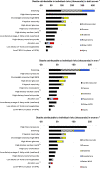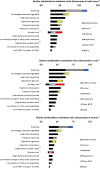The preventable causes of death in the United States: comparative risk assessment of dietary, lifestyle, and metabolic risk factors
- PMID: 19399161
- PMCID: PMC2667673
- DOI: 10.1371/journal.pmed.1000058
The preventable causes of death in the United States: comparative risk assessment of dietary, lifestyle, and metabolic risk factors
Erratum in
- PLoS Med. 2011 Jan;8(1). doi: 10.1371/annotation/0ef47acd-9dcc-4296-a897-872d182cde57 doi: 10.1371/annotation/0ef47acd-9dcc-4296-a897-872d182cde57
Abstract
Background: Knowledge of the number of deaths caused by risk factors is needed for health policy and priority setting. Our aim was to estimate the mortality effects of the following 12 modifiable dietary, lifestyle, and metabolic risk factors in the United States (US) using consistent and comparable methods: high blood glucose, low-density lipoprotein (LDL) cholesterol, and blood pressure; overweight-obesity; high dietary trans fatty acids and salt; low dietary polyunsaturated fatty acids, omega-3 fatty acids (seafood), and fruits and vegetables; physical inactivity; alcohol use; and tobacco smoking.
Methods and findings: We used data on risk factor exposures in the US population from nationally representative health surveys and disease-specific mortality statistics from the National Center for Health Statistics. We obtained the etiological effects of risk factors on disease-specific mortality, by age, from systematic reviews and meta-analyses of epidemiological studies that had adjusted (i) for major potential confounders, and (ii) where possible for regression dilution bias. We estimated the number of disease-specific deaths attributable to all non-optimal levels of each risk factor exposure, by age and sex. In 2005, tobacco smoking and high blood pressure were responsible for an estimated 467,000 (95% confidence interval [CI] 436,000-500,000) and 395,000 (372,000-414,000) deaths, accounting for about one in five or six deaths in US adults. Overweight-obesity (216,000; 188,000-237,000) and physical inactivity (191,000; 164,000-222,000) were each responsible for nearly 1 in 10 deaths. High dietary salt (102,000; 97,000-107,000), low dietary omega-3 fatty acids (84,000; 72,000-96,000), and high dietary trans fatty acids (82,000; 63,000-97,000) were the dietary risks with the largest mortality effects. Although 26,000 (23,000-40,000) deaths from ischemic heart disease, ischemic stroke, and diabetes were averted by current alcohol use, they were outweighed by 90,000 (88,000-94,000) deaths from other cardiovascular diseases, cancers, liver cirrhosis, pancreatitis, alcohol use disorders, road traffic and other injuries, and violence.
Conclusions: Smoking and high blood pressure, which both have effective interventions, are responsible for the largest number of deaths in the US. Other dietary, lifestyle, and metabolic risk factors for chronic diseases also cause a substantial number of deaths in the US.
Conflict of interest statement
The Academic Editor declares that he had no competing interests when the first version of this paper was submitted. After a revised version was submitted, he started working on the global burden of disease from climate change project at the WHO in Geneva. Majid Ezzati is also working on the Global Burden of Disease project.
Figures


References
-
- McGinnis JM, Foege WH. Actual causes of death in the United States. JAMA. 1993;270:2207–2212. - PubMed
-
- Lopez AD, Mathers CD, Ezzati M, Jamison DT, Murray CJ. Global and regional burden of disease and risk factors, 2001: systematic analysis of population health data. Lancet. 2006;367:1747–1757. - PubMed
-
- Mokdad AH, Marks JS, Stroup DF, Gerberding JL. Actual causes of death in the United States, 2000. JAMA. 2004;291:1238–1245. - PubMed
-
- Willett W, Stampfer MJ. Total energy intake: implications for epidemiologic analyses. Am J Epidemiol. 1986;124:17–27. - PubMed
-
- Stahre M, Naimi T, Brewer R, Holt J. Measuring average alcohol consumption: the impact of including binge drinks in quantity-frequency calculations. Addiction. 2006;101:1711–1718. - PubMed
Publication types
MeSH terms
Grants and funding
LinkOut - more resources
Full Text Sources
Other Literature Sources
Medical

